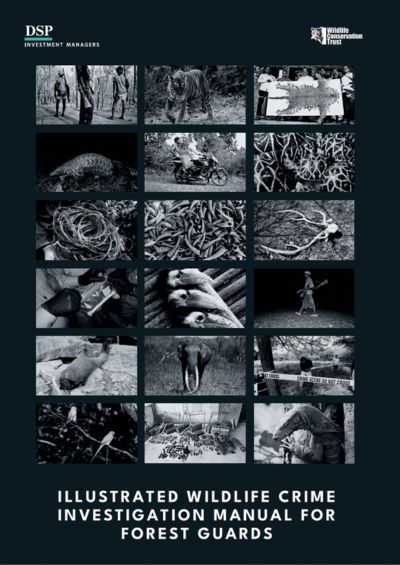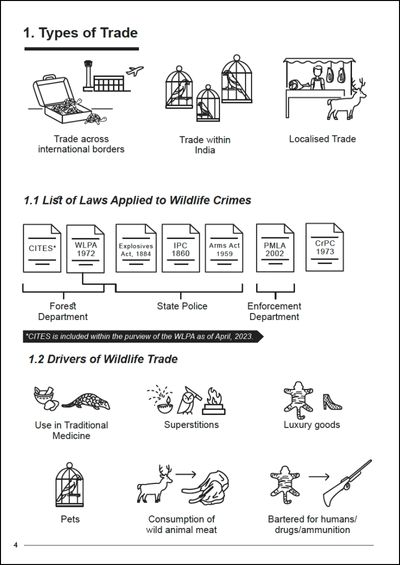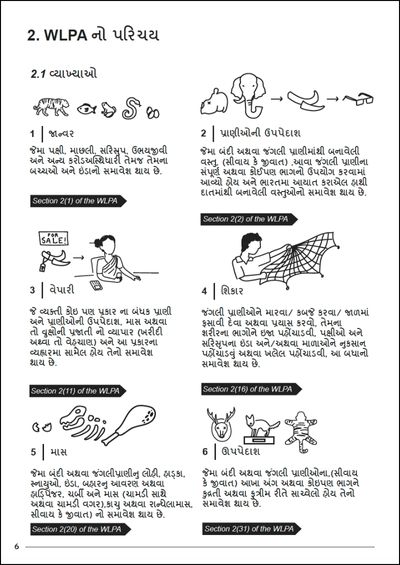Wildlife watchers love a good field guide. It helps them identify plants and animals in the field, and tick off long lists of species they wish to see in the wild. And there are people that walk the wilds, not for leisure, but to dutifully protect wild species and their habitats. They are Forest Department staff – forest officers, guards and watchers. Forest staff wear many hats, and one of them is law enforcement. They are required to prevent, detect and investigate crimes against wildlife, and build strong cases against the offenders to ensure conviction. To help them get better at administering their role, the Wildlife Conservation Trust (WCT) has been training frontline forest staff across the country since 2012. Over the years, the training modules have evolved to also include evidence collection, site security, and the application of forensics to build watertight cases.
The Illustrated Wildlife Crime Investigation Manual was first designed in English and then translated to local languages like Gujarati, Marathi, and Hindi to suit the needs of forest staff in various states. Illustrated manuals designed by Akshaya Elizabeth Zachariah.
Now, all that knowledge has been turned into something that forest staff can carry in their backpacks. The ‘Illustrated Wildlife Crime Investigation Manual for Forest Guards’, produced by WCT with support from DSP Finance Pvt. Ltd. (formerly DSP Investment Managers Pvt. Ltd.), is like a law enforcement field guide for India’s forest staff. Intended to be used as a ready reckoner by forest staff when dealing with cases of wildlife crime, it presents the law with minimum jargon and illustrations for effective visual learning and easy recall. In addition, it also explains the processes of filing a case and prosecuting a wildlife crime step-by-step.
“By breaking down critical legal and technical information and complex processes into bite-sized portions with minimal text and relatable artwork, our goal has been to remove the fear and challenges associated with the use of the Wild Life (Protection) Act, 1972 among frontline forest staff. With the Act being amended in 2022, we seized the opportunity to create these illustrated manuals and translate them into local languages like Hindi, Gujarati, and Marathi, so that forest staff can easily learn the amended Act and implement it effectively in the field,” says Samyukta C., Senior Trainer, Combatting Wildlife Crime programme, WCT.
“When they carry this handy manual in the field, it becomes very easy for the forest staff to recollect what they learned in our training, and apply the right sections of the Act while preparing cases for different offences. It is compact, but every time they refer to it, it provides a revision of the training,” says Sanjay Thakur, Senior Trainer, Combatting Wildlife Crime programme, WCT.
“The manual contains real examples of crime situations we face in the field, and pertinent provisions and sections of the Act to be applied. That makes it extremely helpful for us,” says N.R. Bodhake, Forest Guard, Sahyadri Tiger Reserve.
“I have worked with the Forest Department for 13 years. I have not found a more detailed and helpful crime investigation manual. It guides us, with pictures, on how to document and collect evidence at a crime scene, as well as which sections of the Act to apply and which ones to not apply in different situations, to make a strong case. It also guides us on where to send evidence for forensic investigation. It explains all aspects of law enforcement and crime investigation minutely, and with explanatory illustrations,” says Munishkumar Sajjan, Forest Guard, Bor Tiger Reserve.
“The Illustrated Wildlife Crime Investigation Manual provided by WCT has made learning simple for our staff. All members of our staff are referring to it, as the information, combined with illustrations, is very easy to understand,” says Mangesh Tengdi, DFO, DD, at the Bor Tiger Reserve.
The WCT team is elated by the positive response of forest staff about the usefulness of the manual – yet another milestone in its journey of many years in empowering frontline forest staff to become effective law enforcers, so that India’s forests and other biodiverse areas remain alive with the sights, sounds and scent of wild denizens.
About the author: Rizwan Mithawala is a Conservation Writer with the Wildlife Conservation Trust and a Fellow of the International League of Conservation Writers. He has previously worked as an environment journalist with a national newspaper.
Disclaimer: The author is associated with Wildlife Conservation Trust. The views and opinions expressed in the article are his own and do not necessarily reflect the views and opinions of Wildlife Conservation Trust.
Your donations support our on-ground operations, helping us meet our conservation goals.
Related Links
- Non-palatable alternative medicinal crops
- A Preventive Healthcare Safari for Conservation
- Birding in Tigerland
- Institutional and Corporate Donors
- Meet Dr. Anish Andheria – Scientist, Naturalist, Conservationist, Photographer



